

By Lora Koenig
It’s Thursday, December 1, and I am, yet again, sitting in our office, waiting. As the saying goes, “hurry up and wait”: This rings true in Antarctica. Last week, we were waiting for our radars to arrive on a plane from Christchurch. Usually there are about three flights a week from Christchurch to McMurdo, but an entire week of flights was canceled due to bad weather here. And finally, a plane arrived on Monday, November 28, bringing fresh fruit, new people and, most importantly, our radars.
Ludo and Clem quickly set up the two radars, ran a few tests to make sure they were working and repacked them for shipping to Byrd Camp. Normally we would take a few days to do this but, since we were delayed, we all worked hard and completed the tasks in a few hours. We repacked the equipment very carefully to prevent damage, and put it into the cargo system. (See Michelle’s blog post to learn more about the cargo system). Our intracontinential cargo needed to be in the system 48 hours in advance, and we were hoping to fly to Byrd on December 1 (that is, today).
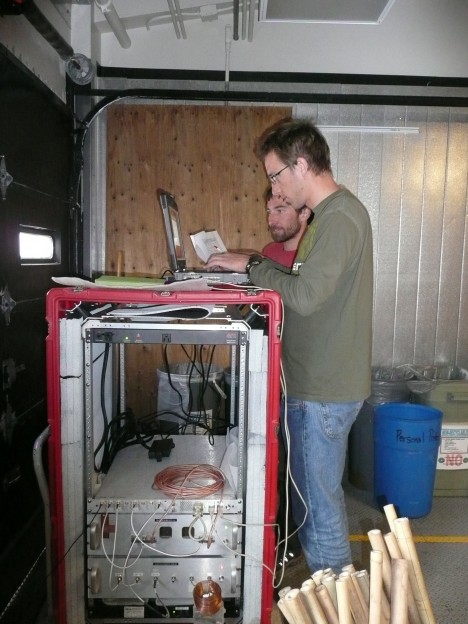
Just as a reminder here is the location we are trying to get to.
So our estimated departure date has come and gone, and here we are still in McMurdo. This is not a big surprise; delays are common in such a harsh environment. We are now scheduled to go to Byrd on Monday December 5. All of our work in McMurdo is done, so we will use the delay to rest a bit before the hard work of the traverse begins.
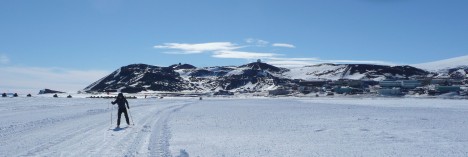
Why are we delayed? First, as I mentioned, McMurdo had a week of bad weather and no planes could land or take off. And once the weather in McMurdo cleared, it was Byrd’s turn to have bad weather, so planes could not land there. On top of that, there is a lot of science going on at Byrd this season, including another traverse lead by a NASA colleague, Bob Bindschadler, headed to Pine Island Glacier. (Check out this video on the Pine Island project, or visit their website.) Because there are so many teams flying to Byrd, we have to wait for five flights to get in before we are assigned a plane load for our science gear, fuel, snowmobiles and ice core boxes. Our team has a full LC-130 plane load of gear that needs to make it to Byrd.
Yesterday, they were finally able to get some flights into Byrd. Our flight number is T012; flight T010 will take off for Byrd this evening, then T011 has to fly and then it’s us. We are watching the monitors in McMurdo that show the flight status, just like at the airports, hoping that flights get in. We cheer when a flight returns and groan when a flight is canceled due to weather.
There is one more issue that is causing delays. This week they are moving the runways at McMurdo. In the early season, when it is still cold, the planes land very close to McMurdo on the sea ice at a place called Icey Runway. As temperatures warm, sea ice thins and the runway is moved farther inland to Williams Field, where the ice is thicker. This weekend is when they move airports, so there are no flights scheduled for Friday or Saturday (normally, there would be flights Monday through Saturday). So we will have another weekend in McMurdo, and when it’s time to fly to Byrd we’ll do it from William’s Field, about a 45-minute drive from McMurdo.
While we were waiting, I finally took some pictures of Percy the Penguin. Percy was given to me by a friend; it came from a geocache site in Seattle, WA and has now made it to Antarctica. Percy is actually the only penguin we have seen here. So far, the only wildlife we have encountered are skuas, large seagull-like birds, and Weddell seals that lounge on the sea ice just outside of McMurdo and Scott base. Through there are no seals in the picture of Michelle skiing, she is on an ice shelf below which the seals could be swimming. When the seals find a hole in the ice they come up onto the sea ice or ice shelf and lounge in the sun.

By Clement Miege
Hello everybody! This is Clement, for my first blog post! Sunday, November 27 was our day off, so we went exploring the surroundings of McMurdo Station. At around noon, Michelle and Lora decided to go cross-country skiing on sea ice while Jessica and Randy went to Scott Base for some shopping at the Kiwi store, which is stocked with lots of Antarctic T-shirts and other souvenirs.
On our side, Ludo and I took advantage of the wonderful weather and hiked the Castle Rock loop. I hiked this trail last year and it is by far my favorite walk near the station. We started at the fire house at around 11:30 AM. Because the trail is pretty long (9.8 miles), we were required to take a radio with us and give our estimated return time and the contact info for our point of contact in town to the responder on duty at the firehouse.
The walk toward the summit of Castle Rock is very pretty, with amazing views everywhere: behind us, we had Mount Discovery and the Royal Society Mountain Range. In front of us, we had incredible scenery with Castle Rock in front of Mount Erebus and Mount Terror. While approaching Castle Rock, we were able to enjoy a nice scramble leading us to the summit, with fixed ropes set for safety on the ascent. After a quick break at the summit, where it was really windy, we decided to head back down.
Here is our hike in pictures so you can enjoy it as well.
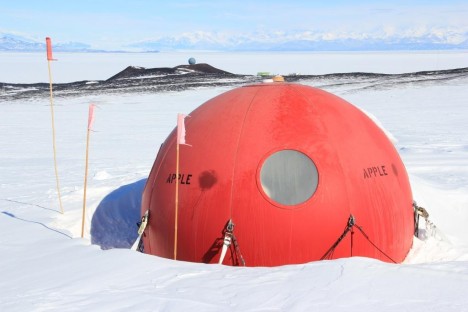
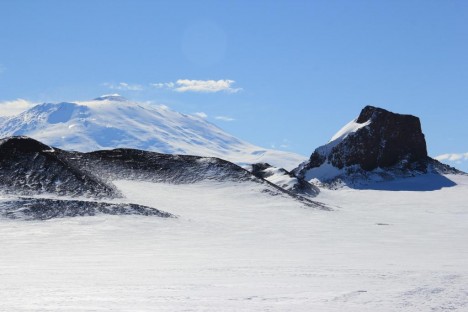

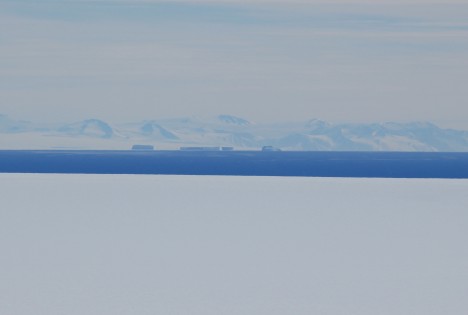

It took us about 4 hours to walk/slide through the whole loop. In fact, we cheated a little bit, taking advantage of the last shuttle to go back to McMurdo station from Scott Base, which knocked off about 2 miles. It was a wonderful trip; it was good to be outside while the weather was nice!
But that wasn’t the end of our day! After dinner, Jessica, Randy, Ludo and I went with a small group to Pegasus runway, an airfield near Mc Murdo station, to visit the remnants of a plane that crashed in 1970 and got stuck in the ice. It took us an hour to get there, travelling in a Delta. After spending a little time checking out the plane, we got back to the station at around 8:30 PM, ready to go to bed after a long day of adventures outside.
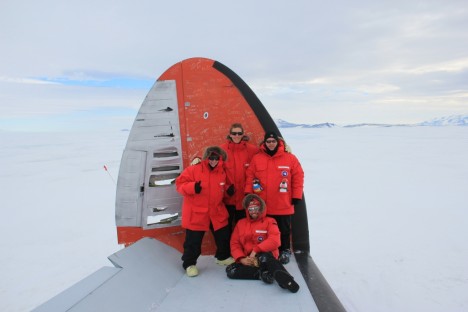

Here are some bits of info that I was able to collect on this crash, where fortunately nobody died. The plane, a C-121J named Pegasus, took off from Christchurch, New Zealand in October 1970. The flight to McMurdo went well until a storm started developing near the runway. Unfortunately, the flight had already passed the point of safe return, which meant that it did not have enough fuel to make it back to Christchurch. The only choice remaining was trying to land with no visibility. After a long time circling above the runway to get a little bit of visual information, the pilots attempted to land and the plane slid into a heavy snowdrift deposed by the storm, spun and broke its entire right wing and finally stopped. Luckily, nobody died in this accident.
If you would like to get more information on this story, follow this link.
Now this site is becoming a touristic attraction but it still shows a part of the Antarctic history. After this dramatic event, more precautions have been taken to allow planes to boomerang back to Christchurch if they run into bad weather.
By Lora Koenig
It is Sunday night, November 27, and I am sitting in our McMurdo office with Michelle. We had a great Thanksgiving weekend. Here on the Ice we celebrated Thanksgiving on Saturday, November 26, instead of on November 24 (the day it was celebrated in the United States). The reason for this is that people in McMurdo work 6 days a week (Monday through Saturday) so when there is a holiday, it is always celebrated on Saturdays to get a full weekend off.
On Friday evening Randy, Clem, Ludo and Jessica toured Discovery Hut. Saturday, our Thanksgiving Day, started with the entire team running in the McMurdo Station Turkey Trot, a 5K race over to Scott Base and back. It was Jessica’s first 5K race ever and she can now say that she ran her first 5K in Antarctica, which I imagine is quite a unique story.
The day concluded with a very nice dinner that included all of the traditional Thanksgiving fare along with handmade truffles.

There was one thing noticeably missing at Thanksgiving dinner, and that was “freshies.” Freshies are how people on the Ice call fresh vegetables. There were no freshies because no plane has arrived McMurdo since November 21. This means there has been no resupply of vegetables, no new people, and no incoming cargo.

Having plane delays due to weather is common and expected in McMurdo. Normally, this would have little effect on us, besides the occasional craving for a green salad, but this year is worse, because the shipping contractor made a mistake. All of the radars that we shipped from Kansas were supposed to be here when we arrived, but they were not.
During our time in McMurdo, we have to complete the following tasks as quickly as possible so we can get on a plane to the field:
1) Find our science equipment and traverse equipment
2) Test all of our equipment to make sure it works.
3) Put all said equipment in the cargo system to get shipped to Byrd and
4) Complete all training and safety classes (See Ludo’s post).
Once these steps are completed, we can schedule our flight to Byrd. We had planned to leave for Byrd on November 30, and we have completed all of our tasks (except for one additional field safety training on Monday, November 28, and a snowmobile training on Tuesday, November 29.) But we cannot leave McMurdo until we get the radars: They are essential to our science. So for now we are sitting and hoping that the next plane that arrives to McMurdo will carry our radars. If delays continue, we’ll have to switch to plan B (or C, or D).
Right now, Plan B is that Clemont may have to stay behind to receive the radars while the rest of the team goes ahead to Byrd camp. But hopefully, the radars will arrive before our plane leaves for Byrd Camp. As soon as the radars arrive, we will test them to make sure nothing broke during shipping, since it is easier to fix things in McMurdo than while in the field. Then we will pack them again for the trip to Byrd.
The weather forecast for Monday doesn’t look great, but here’s hoping we get our radars soon. If you want to follow the weather forecast for McMurdo check out this website or you can virtually look out the window like we do, through the McMurdo webcam.
By Ludovic Brucker
Our military C-17 flight landed on 2.3-meter thick sea ice in McMurdo Sound. McMurdo has three airfields that are used at different times during the austral summer. The sea-ice runway is located a few miles from McMurdo, and it usually operates from October to December, until the sea ice begins to break.
For a large number of us, this is our first time on the southernmost continent on Earth and, as you can imagine, landing on McMurdo Sound’s sea ice felt very special. The first minutes off the plane everyone was looking around and smiling a lot.
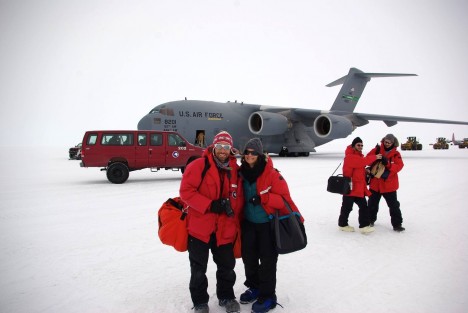
Weather conditions on landing were nice, despite a low cloud that turned everything extremely bright and made it difficult to tell the sky from the snow-covered ice.
Shortly after stepping into the snow, we had to jump into one of the two charismatic vehicles that were ready to transport us to McMurdo Station. We could choose between the famous Ivan the Terra Bus (red as our parka, a.k.a. the Big Red) or an orange delta truck from the early 80s (that vehicle was already carrying people from the runway to McMurdo station before I was born!). Both vehicles have incredibly big tires.
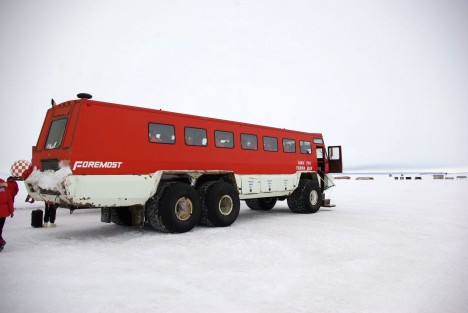

The ride to the station normally takes 15 minutes, but it can be four times longer when sea ice conditions aren’t safe anymore and the runway is then re-located on the ice sheet farther from the station.
After a warm welcome and a short briefing at McMurdo, we got our room keys and headed toward the dormitories. That gave us the first opportunity to walk a bit through the station. McMurdo Station (located 77° 51′ S 166° 40′ E) sits on bare volcanic rock on the coast of Hut Point Peninsula, Ross Island. The station was built in 1955; its 85 or so buildings range in size from a small radio shack to large three-story structures. It is the largest Antarctic station and the logistics center for the U.S. Antarctic Program. There are repair facilities, dormitories (for a maximum of 1200+ people), administrative buildings, a firehouse, a power plant, a water distillation plant, a wharf, stores, clubs, warehouses, and a science and engineering center (where we will spend some time before heading to Byrd, hopefully next week). All the structures are linked by above-ground water, sewer, telephone, and power lines.
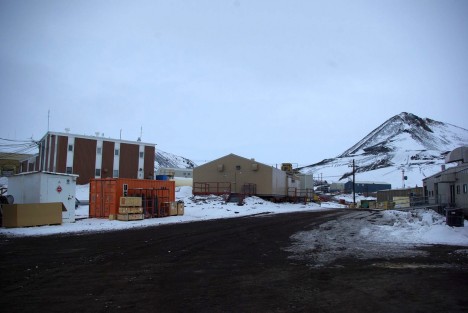
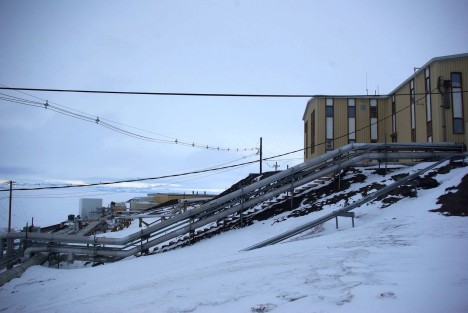
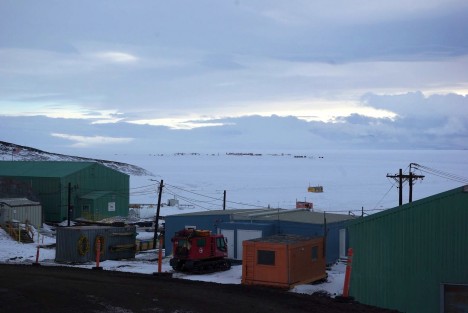
By the time I checked into my room and picked up my bag, a cold, light snow had started to fall. How nice! In the next days, we are going to go through several training sessions, make sure that our scientific equipment made it here undamaged, and prepare our shipment to Byrd station.